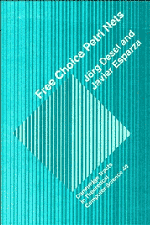Book contents
- Frontmatter
- Contents
- Preface
- 1 Introduction
- 2 Analysis techniques for Petri nets
- 3 S-systems and T-systems
- 4 Liveness in free-choice systems
- 5 The Coverability Theorems
- 6 The Rank Theorem
- 7 Reduction and synthesis
- 8 Home markings
- 9 Reachability and shortest sequences
- 10 Generalizations
- References
- Index
- List of symbols
- List of main results
5 - The Coverability Theorems
Published online by Cambridge University Press: 21 October 2009
- Frontmatter
- Contents
- Preface
- 1 Introduction
- 2 Analysis techniques for Petri nets
- 3 S-systems and T-systems
- 4 Liveness in free-choice systems
- 5 The Coverability Theorems
- 6 The Rank Theorem
- 7 Reduction and synthesis
- 8 Home markings
- 9 Reachability and shortest sequences
- 10 Generalizations
- References
- Index
- List of symbols
- List of main results
Summary
Throughout the rest of the book we study the properties of live and bounded free-choice systems. In this chapter, we prove the S-coverability Theorem and the T-coverability Theorem, which state that well-formed free-choice nets can be decomposed in two different ways into simpler nets. Together with Commoner's Theorem, the Coverability Theorems are part of what can be called classical free-choice net theory, developed in the early seventies.
The S-coverability Theorem
Figure 5.1 shows a live and bounded (even 1-bounded) free-choice system that we shall frequently use to illustrate the results of this and the next chapters. Its underlying well-formed free-choice net can be decomposed into the two S-nets shown at the bottom of the figure. Observe that they are connected to the rest of the net only through transitions. We prove in this section that every well-formed free-choice net can be decomposed in this way.
Definition 5.1S-components
Let N′ be the subnet of a net N generated by a nonempty set X of nodes. N′ is an S-component of N if
•s ∪ s• ⊆ X for every place s of X, and
N′ is a strongly connected S-net.
The two nets at the bottom of Figure 5.1 are S-components of the net at the top. The subnet generated by {s1, t1,s3, t3,s7,t7} is not an S-component; it satisfies the second condition of Definition 5.1, but not the first.
- Type
- Chapter
- Information
- Free Choice Petri Nets , pp. 89 - 110Publisher: Cambridge University PressPrint publication year: 1995



